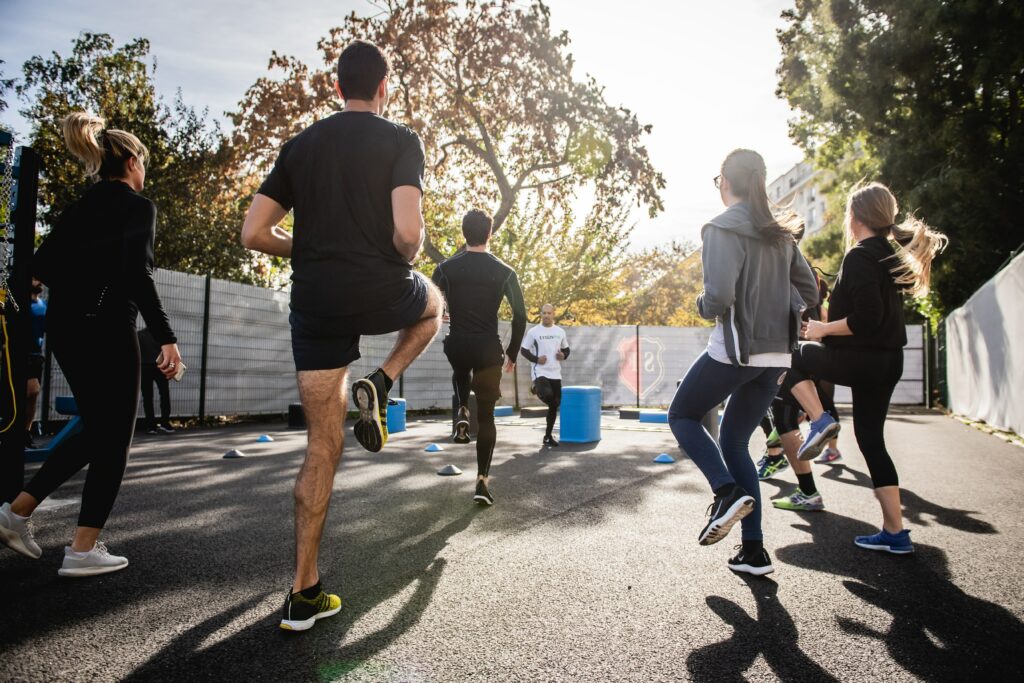If you’re eager to build muscle mass, you’re probably wondering how often you should hit the gym. Well, the answer lies in finding the balance between pushing yourself and allowing your body to recover. Training too frequently can hinder your progress, while too little can slow down your gains. So, in this article, we’ll explore the optimal training frequency to help you maximize your muscle-building potential. Whether you’re a seasoned lifter or just starting out, we’ve got you covered with the information you need to know to get the most out of your workouts.

Factors to Consider
When determining how often to train to build muscle mass, there are several factors to consider. These factors will vary from person to person, as everyone has unique goals and circumstances. By taking these factors into account, you can develop a training plan that is tailored to your individual needs and maximize your muscle growth potential.
Individual Goals
Your individual goals play a crucial role in determining your training frequency. Are you aiming to gain strength, increase muscle size, or improve athletic performance? The answer to this question will guide the frequency and intensity of your workouts. If your main goal is muscle mass, a higher training frequency may be beneficial.
Current Fitness Level
Your current fitness level is another important factor to consider. Beginners who are just starting their muscle-building journey will typically have different training needs compared to intermediate or advanced lifters. It’s essential to consider your starting point and gradually increase the intensity and frequency of your workouts as you progress.
Training Intensity
Training intensity refers to the level of effort and weight used during your workouts. Higher intensity training, such as heavy lifting or high-intensity interval training (HIIT), requires more time for recovery. If you’re consistently pushing yourself to the limits, you may need more rest days between workouts to allow your muscles and nervous system to recover adequately.
Recovery Ability
Everyone’s recovery ability is different, and it’s important to listen to your body. Some individuals naturally recover more quickly than others. If you find that you’re often feeling fatigued or overly sore, it may be a sign that you need to reduce your training frequency or adjust your training program to allow for more recovery time.
Nutrition and Diet
Alongside training frequency, proper nutrition and diet play a crucial role in muscle growth. Consuming an adequate amount of protein, carbohydrates, and healthy fats supports the recovery and repair of muscle tissue. Additionally, proper hydration and nutrient timing can contribute to optimal recovery and muscle building. Consider your nutritional habits and ensure they align with your training frequency.
Beginners
If you’re a beginner who is just getting started with building muscle mass, it’s important to approach your training frequency with care. Here are some considerations for beginners:
Training Frequency
As a beginner, it’s recommended to start with a lower training frequency. Aim to train each muscle group two to three times per week, allowing for adequate rest and recovery between sessions. This frequency allows your body to adapt to the new demands of strength training without overwhelming your muscles.
Full-Body Workouts
For beginners, full-body workouts can be highly effective. These workouts target all major muscle groups in a single session, providing a balanced approach to muscle development. Performing compound exercises, such as squats, deadlifts, and bench presses, can help stimulate muscle growth throughout your entire body.
Rest Days
Rest days are crucial for beginners, as they allow your muscles to recover and adapt to the new training stimulus. Aim to have at least one or two rest days per week to prevent overtraining and optimize your muscle-building potential.
Progressive Overload
Progressive overload is a key principle for muscle growth. As a beginner, focus on gradually increasing the weights you lift or the number of repetitions you perform. This ensures that your muscles are continually challenged and stimulated for growth.
Intermediate and Advanced Lifters
Once you’ve progressed beyond the beginner stage, your training needs may change. Intermediate and advanced lifters can benefit from a higher training frequency and more advanced training techniques. Consider the following factors:
Training Frequency
Intermediate and advanced lifters often have a higher tolerance for training frequency. Depending on your goals, you may benefit from training each muscle group three or more times per week. However, it’s important to listen to your body and adjust your training frequency accordingly.
Split Training
Split training involves dividing your workouts by muscle groups or movement patterns. This approach allows you to target specific muscle groups more intensely. Popular split training options include upper-lower splits, push-pull-legs splits, and body part splits. Experiment with different splits to find what works best for you.
Variation and Periodization
As an intermediate or advanced lifter, incorporating variation and periodization into your training is crucial. Periodization involves cycling your training intensity and volume to prevent plateaus and continue making progress. Varying your exercises, rep ranges, and training methods can help keep your workouts challenging and prevent boredom.
Training Volume
Training volume refers to the total amount of work performed during your workouts. As an intermediate or advanced lifter, you may benefit from higher training volumes compared to beginners. Increasing the number of sets and exercises per muscle group can help stimulate muscle growth and improve overall strength.
Training Frequency Recommendations
Now that we’ve discussed the factors to consider for different fitness levels, let’s explore some training frequency recommendations for different training splits:
1. Full-Body Workouts
For beginners or individuals who prefer a full-body approach, training each muscle group two to three times per week is recommended. Aim to have at least one day of rest between each session. This frequency allows for balanced muscle development and sufficient recovery.
2. Upper-Lower Split
The upper-lower split involves alternating between upper body and lower body workouts. This split is suitable for intermediate lifters and can be performed four times per week (two upper body and two lower body days). Rest days should be included to allow for adequate recovery.
3. Push-Pull-Legs Split
The push-pull-legs split divides workouts into pushing movements (e.g., chest, triceps), pulling movements (e.g., back, biceps), and leg exercises. This split can be performed three to four times per week, depending on your goals and recovery ability.
4. Body Part Split
The body part split involves dedicating specific days to training individual muscle groups. This split is commonly used by advanced lifters who aim to prioritize certain muscle groups for more targeted growth. Depending on the number of muscle groups you focus on, this split can be performed three to six times per week.
5. Push-Pull Split
The push-pull split involves dividing workouts into push movements (e.g., chest, shoulders, triceps) and pull movements (e.g., back, biceps). This split can be performed three to four times per week, allowing for adequate recovery between sessions.
6. Frequency Guidelines for Each Split
When following a split training approach, it’s important to consider the frequency guidelines for each muscle group within the split. Aim to train each muscle group at least twice per week to stimulate muscle growth effectively. Adjust the training frequency based on your recovery ability and goals.

Optimal Rest and Recovery
Rest and recovery are vital components of any training program, regardless of your fitness level. Adequate rest allows your muscles to repair, rebuild, and grow stronger. Consider the following factors for optimal rest and recovery:
Rest Days
Rest days are not only important for beginners but also for intermediate and advanced lifters. Give your body at least one or two days of rest each week to allow for full recovery. Use these rest days to engage in low-impact activities or active recovery exercises.
Sleep Quality
Quality sleep is crucial for muscle recovery and growth. Aim for seven to nine hours of uninterrupted sleep each night. Create a sleep routine that includes winding down before bed and ensuring a comfortable sleep environment.
Nutrition and Hydration
Proper nutrition and hydration are essential for optimal recovery. Consume a well-balanced diet that includes sufficient protein, carbohydrates, and healthy fats to support muscle repair and growth. Stay hydrated throughout the day by drinking plenty of water.
Active Recovery
Engaging in active recovery exercises, such as walking, swimming, or yoga, on your rest days can help improve blood circulation and promote muscle recovery. These low-intensity activities can enhance your overall fitness and aid in muscular repair.
Balancing Intensity and Volume
Finding the right balance between training intensity and volume is crucial for maximizing muscle growth and preventing overtraining. Consider the following factors when balancing intensity and volume:
Training Intensity
Training intensity refers to the effort level and weight used during your workouts. It’s important to challenge yourself during each training session, but avoid constantly pushing yourself to the limit. Incorporate both high-intensity and moderate-intensity workouts to prevent burnout and overtraining.
Training Volume
Training volume refers to the total amount of work performed during your workouts, including the number of sets, reps, and exercises. Gradually increasing your training volume over time can stimulate muscle growth. However, it’s important to avoid excessive volume that can lead to overuse injuries and hinder recovery.
Training Intensity Techniques
To further enhance training intensity, consider incorporating intensity techniques such as drop sets, supersets, or pyramid sets. These techniques can help push your muscles to new limits and stimulate additional muscle growth. However, use them sparingly and allow for proper recovery afterward.
Deloading Periods
Deloading refers to periods of reduced training intensity and volume. Incorporating regular deloading periods into your training program can prevent overtraining and allow your body to recover fully. Deloading can involve reducing the weights and number of sets, or incorporating lighter training sessions.

Importance of Nutrition
Proper nutrition is a foundation for muscle growth and recovery. Consider the following nutritional factors for optimal results:
Caloric Surplus
To build muscle mass, you need to consume a caloric surplus. This means consuming more calories than you burn throughout the day. Aim for a slight surplus of 250-500 calories to support muscle growth while minimizing excessive fat gain.
Protein and Amino Acids
Protein is essential for muscle repair and growth. Consume an adequate amount of high-quality protein sources such as lean meats, poultry, fish, eggs, dairy, beans, and legumes. Aim for at least 0.8-1 gram of protein per pound of body weight per day.
Carbohydrates and Energy
Carbohydrates provide the energy needed for intense workouts. Complex carbohydrates, such as whole grains, fruits, and vegetables, should make up the majority of your carbohydrate intake. Ensure you’re consuming enough carbohydrates to fuel your workouts and aid in muscle recovery.
Fats and Hormone Regulation
Healthy fats play a crucial role in hormone regulation, including testosterone production, which is essential for muscle growth. Include sources of healthy fats in your diet, such as avocados, nuts, seeds, and olive oil.
Timing of Meals and Supplements
Timing your meals and supplements appropriately can optimize muscle growth. Consume a balanced meal or protein-rich snack within one to two hours before and after your workouts to provide your muscles with the necessary nutrients for optimal recovery. Additionally, consider incorporating supplements such as protein powder or creatine to support your muscle-building goals.
Monitoring Progress
Monitoring your progress is an essential aspect of any training program. By tracking your progress, you can identify what’s working and make necessary adjustments. Consider the following areas for tracking progress:
Strength and Performance
Regularly assess your strength and performance improvements. Keep track of the weights you lift, the number of repetitions performed, and the level of difficulty for each exercise. Gradually increasing these measures over time demonstrates progress.
Muscle Size and Definition
Take progress photos or measurements of specific muscle groups to track changes in size and definition. These visual markers can help you assess your muscle growth progress and make adjustments to your training and nutrition plan as needed.
Body Composition Changes
Tracking changes in body composition, including body fat percentage and lean muscle mass, can provide valuable insights into your progress. Consider using methods such as skinfold measurements, bioelectrical impedance analysis, or DEXA scans to monitor changes over time.
Training Logs and Tracking
Keeping a training log can help you stay organized and track your workouts effectively. Note down the exercises performed, weights used, number of sets and repetitions, and any relevant notes or observations. This log can help you identify trends, progress, and areas that may require adjustments.

Listening to Your Body
Listening to your body is essential when determining your training frequency. Everyone is unique, and individual differences should be taken into account. Consider the following factors when tuning in to your body:
Individual Differences
Everyone’s body reacts differently to training stimuli. Pay attention to how your body responds to different training frequencies and adjust accordingly. If you’re consistently feeling fatigued or experiencing nagging pain, it may be a sign that you need to decrease your training frequency or adjust your program.
Recovery Sensitivity
Some individuals naturally recover more quickly than others. Assess how long it takes for your muscles to recover from intense training sessions. If you find that you’re not fully recovered before your next workout, consider reducing your training frequency or incorporating more rest days.
Adjusting Training Frequency
Training frequency is not set in stone and may need to be adjusted throughout your muscle-building journey. Experiment with different frequencies and observe how your body responds. Be open to making changes and find a frequency that allows for optimal recovery and progress.
Injury Prevention
Overtraining and inadequate recovery can increase the risk of injuries. If you start to experience recurrent injuries or persistent joint pain, it may be a sign that you need to reduce your training frequency or modify your training program. Proper rest and recovery are crucial for injury prevention.
Conclusion
Determining how often to train to build muscle mass is a highly individual process. Factors such as individual goals, current fitness level, training intensity, recovery ability, and nutrition all play a crucial role in determining the optimal training frequency. Whether you’re a beginner or an advanced lifter, finding the right balance between training and recovery is key to maximizing muscle growth and preventing overtraining. Listen to your body, monitor your progress, and make adjustments as needed to ensure you’re on the path to achieving your muscle-building goals.



